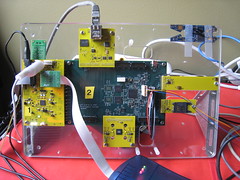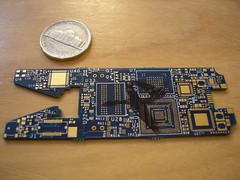Hardware Development Progress
April 13th, 2007 by Claes-Fredrik
 I feel a bit intimidated by the idea of presenting what we’ve done since we last posted updates on the software and hardware development. I think I’ll let the overview slip a bit, and get started with a few recent tidbits.
I feel a bit intimidated by the idea of presenting what we’ve done since we last posted updates on the software and hardware development. I think I’ll let the overview slip a bit, and get started with a few recent tidbits.
We just reached some very exciting milestones on the hardware side, in that we got our first form-factor boards in, as well as early samples of the case. The boards don’t yet have the components placed on them, but they will be “stuffed” shortly. 
To clarify some terminology that we are sure to use a lot, our first hardware prototype had the project name “Falstaff” (not named after the season, although it did arrive in the fall of last year), and the current hardware project goes by “Rosencrantz.”
Rosencrantz is different from Falstaff in a number of ways. I’ll touch on a few of them here.
 It has a new processor, the Freescale (Motorola) iMX31, also used in the Microsoft Zune™, which runs the Windows CE operating system, and (almost—it’s really the iMX21 there) in the Sony mylo™, which runs the Linux operating system, like us.
It has a new processor, the Freescale (Motorola) iMX31, also used in the Microsoft Zune™, which runs the Windows CE operating system, and (almost—it’s really the iMX21 there) in the Sony mylo™, which runs the Linux operating system, like us.  Our previous processor, the Sharp 404 (wonderful name, BTW, for those who know HTTP—the full name is LH7A404) processor was discontinued, and we had a number of issues with the operating system and drivers we chose for it.
Our previous processor, the Sharp 404 (wonderful name, BTW, for those who know HTTP—the full name is LH7A404) processor was discontinued, and we had a number of issues with the operating system and drivers we chose for it.
- It has more Random Access Memory (RAM), that we use to store scan and audio data while processing it, storing it to flash, or sending it off to the host computer. We would have loved to squeeze in a 128MB module, but ended up picking a 64MB module, due to size constraints. Falstaff only had 32MB, allowing us about 3 seconds worth of scan data without processing, compression or sending off to flash or to the host.
The 3 seconds is an important figure, because novice pen wielders tend to move it excruciatingly slowly, quickly eating up buffer space unless we compress images or throw out redundant frame data. - The optics are no longer housed in air. We’ve put a half-pipe meniscus (carved-out cylinder) where the pen touches the paper, for a number of reasons.
For one, this eliminates dust, lint and chewing gum from entering the pen and deteriorating the optics. Second, it affords us a somewhat hyperbolic view of the paper, meaning we see more to the sides the further from the center we go, which can be useful in detecting the distance between words.
Third, and these are by no means in order of importance, it provides what we’ve found to be a very pleasant scanning experience. You get a clear indication of where the optical path of the pen hits the paper; you get a fascinating distortion close to the actively scanned text, which suggests and reinforces the extraction of the text into the pen; and, you can provide nice color effects in the cylinder, to indicate highlight color, success and failure, etc. - Oh, and one more thing. We’ve reinvented the button. Maybe that’s overstating it, but we have added a very cool button, which I’m sure we’ll talk more about on the blog shortly.
We’ll start trickling in further updates, reviews of what we’ve done over the past half a year or so, and provide more news on the software side, where we are implementing a very cool, interesting, and buzz-word compliant Service Oriented Architecture. If we do it right, and we’re doing pretty well so far, our Life Library view will be the envy of iApps everywhere in its ability to deal with large data sets.

April 14th, 2007 at 6:21 am
Great post! And great progress. It is wonderful to see how things come together in a beautifull manner. It is looking good.
Please, keep posting about the business/product as it is the common thread that links some of us who, albeit indirectly, became emotionally involved with Exbiblio.